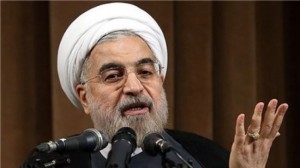 Hossein Roodsarabi recalled how 35 years ago he helped fellow revolutionaries in his hometown of Sabzevar loop a wire noose around the neck of a statue of the soon to be deposed Shah of Iran.
Hossein Roodsarabi recalled how 35 years ago he helped fellow revolutionaries in his hometown of Sabzevar loop a wire noose around the neck of a statue of the soon to be deposed Shah of Iran.
“A Mercedes-Benz was passing and the driver let us take his tow cable,” he said on the eve of this month’s official anniversary of the 1979 uprising that swept aside Mohammed Reza Pahlavi and later led to clerical rule. Clambering up a ladder, the men put the cord in place and tied the other end to a truck. “The statue broke off at the legs,” he said.
Nearly four decades on, the 58-year-old wants a return to the issues of social justice that sparked the revolt against an autocratic monarch. As Iran and world powers resumed talks this week on a permanent nuclear accord that could throw open Iran’s economy, Roodsarabi supports President Hassan Rouhani’s pledge to share the spoils more widely and curb the graft that thrived amid sanctions and isolation.
“Middlemen in business and government are abusing their positions and many don’t have qualifications for what they’re doing,” said Roodsarabi, who also fought in the 1980s war with neighbor Iraq. “They’re far away from the cultural values of the revolution.”
Rouhani, who took office in August, has vowed to rebuild confidence in government and provide Iranians with more freedoms and jobs, expanding an agenda that’s so far focused on improving ties with the West. In an anniversary speech in Tehran’s Azadi Square on Feb. 11, he called for support in the fight against corruption.
‘Cliff-Edge’
His willingness to curb a nuclear program at the center of a decade-long standoff has faced opposition from within Iran’s hierarchy headed by Supreme Leader Ayatollah Ali Khamenei, who has alternated support for Rouhani’s diplomacy with attacks on the U.S.
To achieve his aims at home, the president needs to move cautiously, balancing the expectations of change he has unleashed while avoiding damaging confrontations with opponents.
“Rouhani inherited the country when economically and socially it was on a cliff-edge,” Saeed Laylaz, an economist and adviser to Mohammad Khatami, the reformist Iranian president who repeatedly clashed with hardliners during his eight years in office, told the Shargh newspaper this month.
Among the lessons Iranians have learned is “that we must not insist on big changes taking effect at speed,” Laylaz said.
While Rouhani, 65, scored a foreign-policy success and some relief from sanctions with an interim atomic accord in November, the economy needs attention. The International Monetary Fund on Feb. 12 forecast growth of 1-2 percent in the year starting in March and urged deep-seated reforms.
Pepsi Protest
At the World Economic Forum in Davos, Rouhani declared Iran open for business even as most sanctions imposed over its nuclear research remain in place. The U.S. and its allies charge Iran with seeking to build nuclear weapons, which it denies.
In the weeks following the statue’s toppling in Sabzevar in Iran’s northeast, Roodsarabi demonstrated outside the Tehran offices of Pepsi Cola, watched as government banks were set ablaze and saw activists shot dead by forces loyal to the shah.
After strikes and demonstrations led by leftist and Islamic groups swept the country, the last Persian monarch left for exile. Ayatollah Ruhollah Khomeini was welcomed as he returned to take charge before leading Iran toward an increasingly authoritarian theocracy.
Queen’s Choice
Roodsarabi now runs his building firm from a middle-class Tehran neighborhood, one of those who gained unprecedented economic mobility through the revolution, while established elites lost privileges or went into exile.
“I was nine when I first started working,” Roodsarabi said. “There were six of us children and we would sleep under one duvet. Today, we all have a separate home, cars, TVs.”
The construction business funded a degree in software engineering for a daughter, the family’s income growing each year despite the faltering economy.
Another Tehran businessman, who declined to give his full name in order to avoid repercussions from discussing politics, welcomed Rouhani’s presidency.
As the revolution gathered pace, the then 44-year-old Arjang was setting up an outlet on a well-heeled thoroughfare in northern Tehran. Among his customers was the shah’s first wife, the Egyptian-born Queen Fawzia.
Populist Economics
While many of wealthy clients left the country, so did the Jewish families who had dominated the perfume trade, he said at a company store on Africa Boulevard, a luxury shopping destination.
He’s turned the chain into Iran’s biggest fragrance importer, a distributor for companies such as Spain’s Puig, which includes the Nina Ricci and Paco Rabanne brands.
Echoing Roodsarabi’s criticism of a wealth-capturing bureaucracy, Arjang welcomed the change in tone that has accompanied Rouhani’s presidency.
“People have made lots of money from being middlemen, intermediaries,” he said. “Rouhani wants to rebuild confidence and that’s the most important thing.”
The combination of populist economics, nuclear defiance and rhetoric aimed at the U.S. and Israel during the presidency of Rouhani’s predecessor, Mahmoud Ahmadinejad, fueled 40 percent inflation, brought tighter trade sanctions and capital controls, and left a quarter of young Iranians without work.
Roodsarabi, who backed Ahmadinejad before tiring of his economics, said the revolution was never completed.
While it improved his life, he’d been “looking for a cultural change,” he said. “I wanted there to be brotherhood and sisterhood, everyone to have a conscience.”
By Bloomberg
The Iran Project is not responsible for the content of quoted articles.

 QR code
QR code